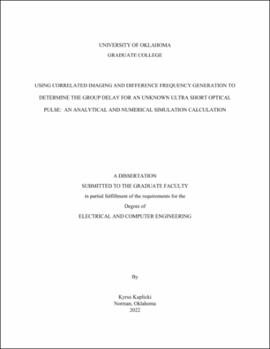| dc.contributor.advisor | Refai, Hazem | |
| dc.contributor.author | Kuplicki, Kyrus | |
| dc.date.accessioned | 2022-05-18T21:24:18Z | |
| dc.date.available | 2022-05-18T21:24:18Z | |
| dc.date.issued | 2022-05-13 | |
| dc.identifier.uri | https://hdl.handle.net/11244/335824 | |
| dc.description.abstract | A pulse laser emits ultrashort optical pulses with pulse widths on the order of pico-seconds and narrower. A full characterization of these optical pulses requires complete knowledge of their corresponding spectral amplitude and phase. Once complete knowledge of the corresponding spectral amplitude and phase are known for a pulse it can then pass through a pulse modulator to be manipulated to nearly any desired shape. While spectral amplitude is easy to achieve, the square root of measured spectral intensity, spectral phase is unobtainable with current measuring equipment. Group delay is the derivative of spectral phase with respect to frequency. Spectral phase is the integral of group delay with respect to frequency plus a constant frequency independent phase. While group delay can be determined by the following techniques: frequency resolved optical gating (FROG), spectral phase interferometry for direct electric-field reconstruction (SPIDER), and multiphoton intrapulse interference phase scan (MIIPS) a new way of determining group delay is presented.
Determining group delay is achieved through the combination of four things: difference frequency generation in a nonlinear material, a frequency to spatial conversion, a binary spatial light modulator (BSLM), and correlated imaging (aka ghost imaging). A newly generated frequency due to difference frequency generation has a phase that is a result of an integral sum of phase differences. This phase can be determined as a result of frequency down shift due to difference frequency generation. Correlated imaging uses two detectors: one detector spatially resolves an incident field upon an object while the other detector which has no spatial resolution measures the fields response to the object. An image of the object is formed through the cross correlation of the two detectors involving many different realizations. By using a frequency to spatial conversion and BSLM we can select which frequencies contribute to the integral sum of phase differences. By correlating the contributing frequencies to the resulting phase of the newly generated frequency through many different BSLM realizations group delay can be determined. Group delay is shown to be able to be determined this way through analytical calculations and numerical simulation. | en_US |
| dc.language | en_US | en_US |
| dc.subject | group delay | en_US |
| dc.subject | optical pulse | en_US |
| dc.subject | correlated imaging | en_US |
| dc.subject | ghost imaging | en_US |
| dc.title | Using correlated imaging and difference frequency generation to determine the group delay for an unknown ultra short optical pulse: An analytical and numerical simulation calculation | en_US |
| dc.contributor.committeeMember | Sluss, James | |
| dc.contributor.committeeMember | Cheng, Samuel | |
| dc.contributor.committeeMember | Hamlin, Daniel | |
| dc.date.manuscript | 2022-05-03 | |
| dc.thesis.degree | Ph.D. | en_US |
| ou.group | Gallogly College of Engineering::School of Electrical and Computer Engineering | en_US |
| shareok.nativefileaccess | restricted | en_US |
